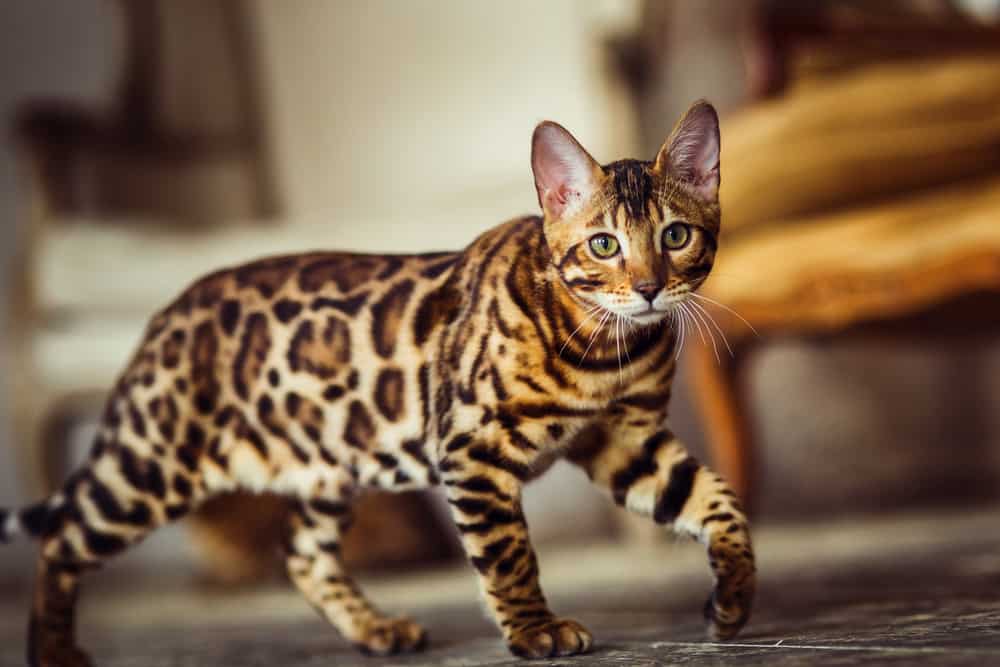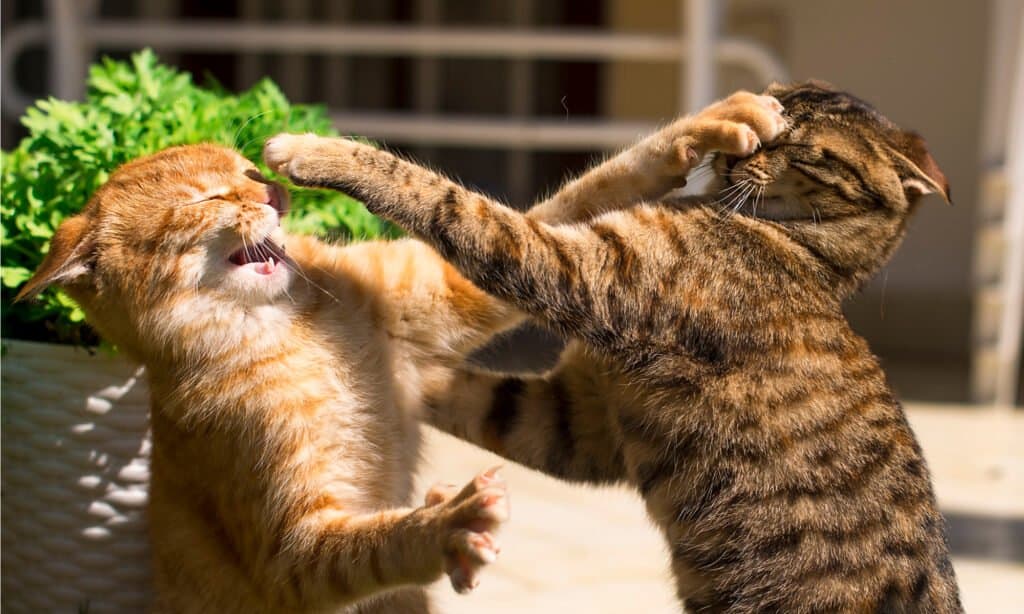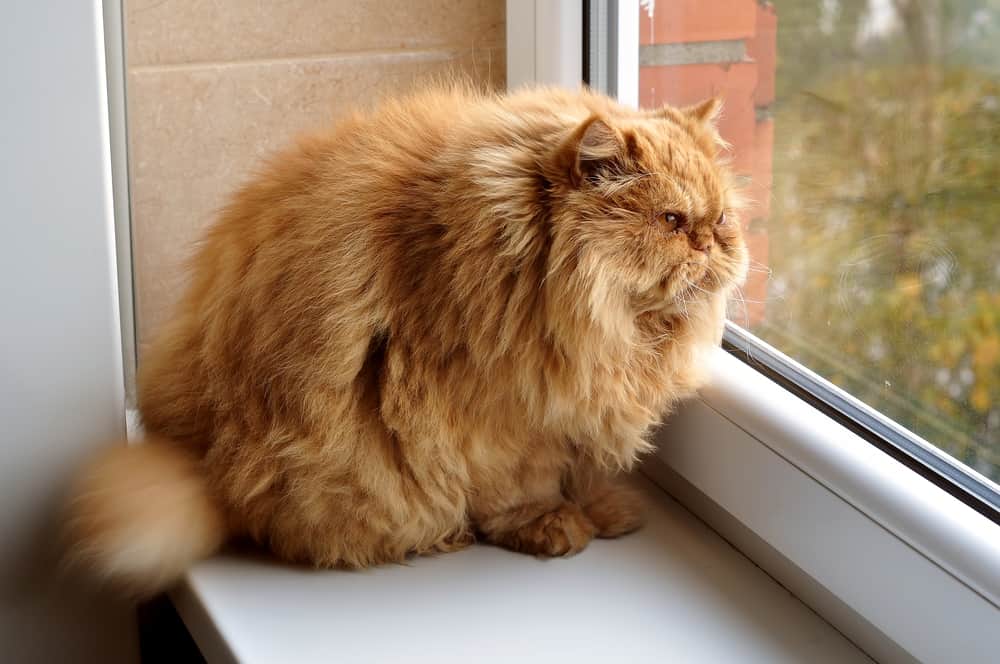Are you a cat parent who can’t help but notice that your healthy-weight cat walks around with a flabby belly that swings from side to side? You worry that you’re not raising your cat properly or that it’s been sneaking treats.
The swaying abdominal flap known as the “primordial pouch” is present in all cats, so don’t worry. In actuality, it’s not even a stomach. Here is all the information you need regarding your kitty’s primordial pouch.
What Is A Primordial Pouch?

The primordial pouch is a sagging flap that hangs loose on a cat’s underside, becoming more prominent near the hind legs.
© Alexander_Evgenyevich/Shutterstock.com
The primordial pouch is a saggy flap made of small amounts of fatty tissue and extra loose skin found under a cat’s belly. Although it extends along the length of the cat’s underside, it usually becomes more obvious close to the back legs.
As the name implies, the pouch develops early in a cat’s life and is an essential part of its physical makeup. It becomes more visible as cats grow out of kittenhood around the age of six months. Think of it like the scruff or excess skin that cats have on their necks. This is where mother cats use their teeth to pick up their kittens.
All cats have primordial pouches, even the big, non-domestic cats such as lions, tigers, and cougars. However, they vary in size. This mix of fat, skin, and fur could be very prominent, depending on the breed, size, and genetic makeup of your cat. Some cat breeds with the most prominent pouches include Egyptian Mau, Pixie Bob, Bengal, and Japanese Bobtail.
The Egyptian Mau is an adorable spotted cat renowned for its incredible agility and acrobatic abilities. The breed is capable of running at speeds of up to 30 miles per hour. It’s possible that its primordial pouch contributes to this impressive speed.
The Bengal breed needs no introduction. Both its protruding primordial pouch and tiger-like coat reflect its unusual ancestry. The breed was developed by mating wild Asian Leopard Cats with Egyptian Maus, Abyssinians, and other domestic cats.
Japanese Bobtails are distinguished by their slim builds, which really highlight their primordial pouches, and short, stubby tails.
As cats age, they lose muscle mass and skin elasticity similar to humans. This could cause their pouches to hang a little lower. How big your cat’s pouch appears also depends on its shape and weight distribution. In fact, if your cat’s pouch appears unusually large, it may be a sign that your cat is in excellent health. The reason for this is that overweight cats often have larger midsections in general, which can hide the pouch. A cat who is thinner may have a pouch that stands out more in relation to the rest of its body.
Why Do Cats Develop Primordial Pouches?

The primordial pouch may offer protection for a cat’s vital organs during a match with a rough playmate.
©Mariya Ilmaz/Shutterstock.com
While veterinarians aren’t sure why cats have primordial pouches, there are three main theories as to how your cat’s hanging belly developed. According to these theories, a primordial pouch does more than just store loose litter or entertain goofy cat admirers.
Protection
Cat play often appears aggressive, whether it’s two domestic cats playing rough or two leopards scuffling in the grassland. Toys, playmates, and even your ankles are under the control of your feline pet, thanks to its teeth and claws. You might even have a few scratches that prove this.
The loose skin of the pouch protects your cat’s internal abdominal organs, including the liver. Have you ever seen your house cat perform a bunny kick on a catnip toy? Cats kick a lot, and the primordial pouch, according to the theory, acts as an additional layer of protection when the claws and teeth are exposed, preventing severe injuries. It is especially useful in combat situations for wild cats.
Flexibility
Cats are skilled acrobats aided by their primordial pouches. They have the ability to twist, wiggle, and leap into the air because their powerful hind legs can be extended by the extra squishy underside. With this flexibility, they can cover more distance with each stride and move much more quickly. These features are useful to both domestic and wild cats, whether they are leaping on your workspace, evading predators, or pursuing prey.
Food Storage
Another theory is that it’s especially useful for wild cats when food is scarce. Here, you can imagine the pouch as a cat’s preferred pair of track pants. Thanks to the elasticity of a primordial pouch, a cat’s belly can expand to reserve some extra food after a particularly large meal. Unlike your overindulged furbaby running around your house, wild cats don’t have access to anyone to prepare their food.
Is A Primordial Pouch Dangerous To Cats?
No, a primordial pouch is not harmful to cats. Although the exact function of the pouch is unknown, all of the current theories are advantageous to cats. On the other hand, being overweight is definitely detrimental to your cat and can cause a number of illnesses, including diabetes, heart disease, and arthritis.
Is My Cat Overweight?

An overweight cat will have a much rounder body overall than one that’s a healthy weight with a large primordial pouch.
©Zanna Pesnina/Shutterstock.com
How do you tell the difference between a prominent pouch and an overweight belly?
Usually, bellies don’t swing the way pouches do when cats walk or run. To determine your cat’s weight status, look at its overall body shape. Obese cats have rounder bodies when compared to healthy-weight cats with large pouches.
There’s a layer of fat in an overweight cat that makes it difficult to feel their ribs or other bony areas. Even the thinnest cat has a pouch. When you touch your cat’s abdomen, you probably feel its ribs and joints rather than this layer of fat.
When you look at your cat from above, you should see an indentation around the waist area if they are a healthy weight. The belly of an obese cat starts at the top of the underside and extends all the way down. A primordial pouch begins further down and is skewed toward the back legs.
Consult a veterinarian to run a test called “body condition score” on your cat to clear up any confusion. This will enable you to assess the weight of your feline companion. Your veterinarian can also assist you in creating a diet and exercise regimen that is suitable for the condition, level of activity, and special dietary requirements of your cat.
What Else Could Cause A Cat-Hanging Belly?
Aging
The loss of skin elasticity with age is a biological phenomenon that contributes to belly expansion. Older cats tend to have a primordial pouch that is more noticeable because the extra skin on the abdominal flap may sag more.
As your cat ages, its metabolism slows down, making it harder to lose weight. For this reason, it’s even more crucial that you stop weight gain in its tracks. When your cat reaches the age of seven, discuss with your veterinarian the possibility of switching to a cat food designed for senior cats.
Breast Cancer
Female cats can develop breast cancer, which typically manifests as lumps in the abdomen. Although not all lumps in your cat’s pouch are cancerous, you should still schedule a visit with your veterinarian if you notice any.
Although they are relatively uncommon, benign fatty tumors known as lipomas can develop in some cats. Regularly checking your cat’s pouch will help you and your veterinarian identify any unusual developments and take immediate action to treat them.
Pregnancy, Neutering, and Spaying
There’s a chance that your female cat’s sagging belly is a sign of pregnancy if she wanders outside the house and isn’t spayed. The bloated belly first appears in a pregnant cat around the 5th week. Avoid touching your cat’s belly if you think she might be pregnant; doing so could harm the unborn kittens. A visit to the veterinarian can and should be used to confirm pregnancy.
If your cat undergoes a spaying or neutering surgery, it may gain some weight after the procedure. The primordial pouch is unaffected by these procedures, but the hormonal changes that follow them may cause them to eat too much and gain weight around their midsection.
As always, it’s important to discuss a new diet with your veterinarian and keep in mind the unique nutritional needs of kittens if you have any.
Why Are We Obsessed With The Primordial Pouch?
The internet is flooded with cats and the primordial pouch. There are various pages, social handles, and hashtags dedicated to the cute little bellies and owners playing with them in various ways. Psychiatrists have identified this obsession with the human urge to associate anything cute, small, and adorable with babies or childlike behavior. This is why more often than not cats and other pets are referred to as babies and the owner as cat-parent or pet-parent. The same applies to the ‘primordial pouch’ as it is a soft fluffy part that makes the cats look cute and adorable.
Pop Culture Names Associated With The Primordial Pouch
Many cat owners have associated the primordial pouch with many different objects such as the ‘coin pouch’, ‘snack pack’, Other than that some other popular names are:
- Tum-tum
- Cookie pouch
- Fluff armor
- Swiffer
- Jelly belly
- Jungle pouch
- Pudding belly
Most of these names refer to the belly being big due to overeating or belly being so low that it is able to sweep the floor.
Conclusion
Having learned more about your cat’s primordial pouch, you realize that it is simply another aspect of your cat to adore, so keep enjoying the cuddliness. However, keep track of your pet’s size and schedule regular vet visits. Check your cat’s weight if you believe that the pouch is becoming more than just a cute magnet for belly rubs.
The photo featured at the top of this post is © monster_code/Shutterstock.com
FAQs (Frequently Asked Questions)
Can cats lose their primordial pouch?
What breeds of cats have primordial pouches?
All cats have primordial pouches but the breeds that have the most evident pouches are the Egyptian Mau, Japanese Bobtail, Pixie Bob, and the Bengal cat. As well as the mix of these and other breeds, it is more common in male cats than in females.
Thank you for reading! Have some feedback for us? Contact the AZ Animals editorial team.






